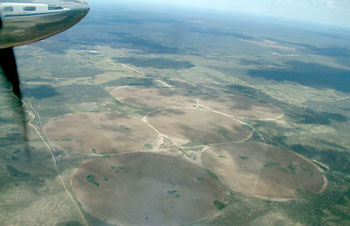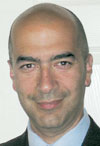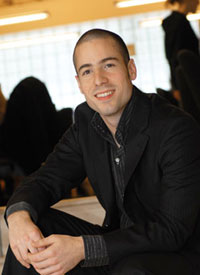
ifty years ago next year, in a small town just west of Idaho Falls, Idaho, the first light bulb to be powered purely by nuclear energy was illuminated. The municipality of Atomic City was born.
In early May, near what is now the Idaho National Engineering & Environmental Lab (INL) run by the U.S. Dept. of Energy, French multinational Areva, Inc., lit up the region with the announcement that it would construct a US$2-billion uranium enrichment facility on a parcel approximately 18 miles (29 km.) west of Idaho Falls, in Bonneville County. While expected to employ 300 when operational, its economic impact is projected to be near $5.1 billion. Its broader impact could be felt throughout a nation pointed toward a nuclear power revival.
Areva picked the site over other finalists in five states, including another in Idaho, says Sam Shakir, general manager for Areva’s strategic enrichment program, from his Washington, D.C., office.


A team made up of technical, legal, financial, environmental and communications experts teamed up with Colorado-based MWH Global to analyze the playing field. The process, launched a little over a year earlier, began by running a large number of sites through “go/no go” criteria such as environment and geology, then subjecting a number of qualified sites to a more detailed examination.
“We call it a multi-attribute utility analysis – MAUA,” he says, encompassing 39 technical, environmental, operational and economic criteria. “From there we scored the sites, which got it down to 10 at that point. Then there was really a phase three, though not formally, when we looked at things through another filter that was more business oriented, looking at the economics, and at community and political support.”
That filter left five sites to sift through, in southeastern New Mexico, Ohio, Washington and Idaho.
“When we were down to the last round, a focus on economics was the key driver,” says Shakir. “And availability of the work force was a key criterion. You can convert everything to economics at the end of the day. And it doesn’t mean tax incentives, but the overall economics of doing business in a state or location – utility costs, land costs, implementing project, labor costs.”
Doing their part to help, Idaho legislators helped their state rise above the rest by passing two significant measures that helped cement the deal.
“There were two areas where there was a significant gap between the State of Idaho and some of our competition,” explains Linda Martin, executive director of Grow Idaho Falls, “real property tax, and the lack of a sales tax exemption on equipment.” So a core working group including Martin’s agency, the state department of commerce and the office of U.S. Sen. Larry Craig got to work examining existing statutes to see if Areva’s operation could somehow fit.
When a solid fit was not found, Martin says, the only options were to amend statutes or introduce new laws. Both paths were taken.
“House Bill 561 addressed the tax exemption on production equipment, and we managed to expand the definition to apply to not only uranium enrichment, but other categories within the fuel cycle,” she says. “Then House Bill 562 addressed the real property tax by establishing a seven-year project period in which any company could expend $1 billion or greater in any one county, and as a result of that spending they would have a cap of $400 million on the real property. We ended up calling that the New Capital Investment Incentive Act.”
Martin credits a roster of organizations including the Eastern Idaho Economic Development Partnership, the statewide chamber alliance, the Partnership for Science and Technology, state house and senate committee members and the state associations of counties and cities. Areva’s Shakir says the measures put Idaho on a par with the other states. And he says the teamwork was noticeable.
“One thing we saw was a complete alignment between state and local government and their federal representatives here in Washington,” he says. “The support was very strong and evident. It wasn’t so much the legislation itself, but the way it was handled – the way it was voted through their legislative process – that was more impressive.”
Both Martin’s agency and the company stand ready for the public hearing and PR effort that will now ensue. But she too was impressed at the speed of state law.
“To have two bills going though the House committee to the floor, to the Senate committee and floor, and to the governor’s desk in six weeks, un-amended, is quite a credit to the state legislature and to the governor’s office,” she says.

Also passed during the Idaho legislature’s 2007 session was funding for the $17-million Center for Advanced Energy Studies at INL. Expected to be complete in August 2008, its purpose is to foster sound energy policy and R&D.
Dr. Ralph Bennett, director of international and regional partnerships for INL, says the lab brought expertise in four areas to the table early in Areva’s site search: electric power transmission, environmental permitting, seismic activity and water. The technical guidance INL offered was backed by 50 years of accumulated data, within a national laboratory facility that encompasses nearly 900 sq. miles (2,331 sq. km.), right next door to the site under examination. Not a bad card to have in your hand, some would say.
“I think we all knew from the start it was a point of real competitive advantage, and we hit it hard,” says Bennett.
Among the reassurances gleaned from the data was the fact that the location is near the connection of three different independent power companies. The seismic data, says Bennett, was important because centrifugal enrichment plants have extremely high-speed rotating equipment, and so are susceptible to the effects of vibrations.
At one point, there was discussion about offering a site on INL property, but “even though we have plenty of space on the property, we could tell that they were looking at a purely commercial enterprise,” says Bennett. “The things we could offer as a lab,” such as security forces and exclusion zones, “were not going to make a difference.”
Bennett says the new Center for Advanced Energy Studies is owned by the Idaho University Consortia (Idaho State University, University of Idaho and Boise State University), which will have the majority of people occupying it.
“We are excited to have a place to collaborate with university researchers, where we can build a research portfolio,” he says. “There are grants universities can bid that labs can’t.”
Yet the lab, run by Battelle, can offer its array of amenities, such as test rigs. Bennett says INL is modeling its efforts after successful efforts by other labs and schools in other states, including Battelle’s operations at the Pacific Northwest National Laboratory in Richland, Wash., and Oak Ridge National Lab near Knoxville, Tenn.
While there are no federal incentives for uranium enrichment projects, there is a $2-billion provision for enrichment facilities funding that Areva will be looking to mine for a portion of its project, says Shakir.
The Idaho project will mirror a similar plant now heading for completion in France. The Georges Besse II plant is expected to be producing in 2009. Shakir says the Idaho project should be able to profit from design, equipment and systems lessons learned during the French project’s development. He also notes that even though the French plant’s capacity will be more than twice the Idaho facility’s and the nations’ regulatory processes are different, the plants are similar, as is the time frame for implementation.
“We will engage with the Nuclear Regulatory Commission over two to three years, break ground in 2011, with the target of starting operations in 2014,” he says. Helping the project get through the regulatory process will be the fact that it’s handled by a different branch of the NRC than the nuclear power plant division.
The project has been preceded in line by uranium enrichment plant projects from USEC and Louisiana Energy Services, whose plants are in the development process in Ohio and New Mexico, respectively. “Subsequent applications are, in theory, faster to review,” says Shakir. (Another joined the queue a week before Areva’s announcement, when GE Hitachi announced both an enrichment project and a corporate campus expansion in Wilmington, N.C.)
Internationally, current projects at different points in the enriched uranium fuel cycle include a centrifugal enrichment facility in Honshu, Japan, from PNC and another from Cameco in Port Hope, Ontario.
One problem plaguing the USEC project has been a run-up in costs, with the centrifuge plant now expected to cost $3.5 billion, or more than double the original estimate. Asked about what site selection factors may help Areva avoid a similar scenario, Shakir says the key cost driver is Areva’s technology.
“We’ll be using technology that is mature and proven, and which has been in operation for decades,” he says. “In that regard, there should be no surprises. Site selection does tie in to the overall costs of the facility, because it dictates how the facility is designed. We factored that into our analysis, and made sure the Idaho site met the criteria and we understood the economics of that selection.”
And while costs and waiting lines for special steel forgings are just one of the spending issues for the queue of new nuclear plants lined up for NRC approval, Shakir says Areva’s plant will not have that problem.
“This facility is really a chemical plant, not a nuclear power plant,” he points out. “There are no heavy forgings of an exotic nature that have to be ordered from special suppliers around the world. So, in that sense, the risk of costs running up on us is manageable.”
Touts Its Own Digital
Media Cluster

uébec City’s vibrant cluster of video game developers is much smaller than that of its provincial rival Montréal, but it is growing and can boast of some pretty famous products. One of the fastest growing firms is Beenox, which plans to occupy five stories of a new office tower by the end of the year.
Beenox’s rise has been rapid, moving from the six guys who founded the company in 2000 to more than 200 eight years later. Just last year the company employed 75. Activision, the world’s second largest video game publisher, acquired Beenox in 2005. The new office space will consolidate operations from three buildings and provide space as the company grows to more than 250 employees in 2009.
“It’s been a pretty good ride,” says company founder and CEO Dominic “Dee” Brown.
Indeed, it is been a meteoric rise for Brown, who at the age of 15 announced that he would conquer the world with his own video game company. He dropped out of high school, and after working for another game company for a few years,

he left to help form Beenox.
“I’m a native of Québec City and I love the creative space here,” says Brown, now 29, “but when Activision acquired us, we had to prove that Québec City is a good place to expand.”
Beenox has developed an array of games based on recent popular movies, and is one of the leaders in the socialization trend in video games.
“We just announced a game for the Guitar Hero series, the top selling brand of 2007,” Brown says. “It’s a money printing machine, and we are pretty glad to have that in our studio.”
Earlier this year, Beenox released a Bee Movie game and is currently working on a game based on the next James Bond movie for Nintendo.
Beenox is among the companies benefiting as games become more of a “we” experience rather than a “me” experience.
“Video games are expanding to a much more social experience,” Brown says. “It’s a true revolution and a whole new living room experience. In the next few years, the demographics of the video game industry will change dramatically. There will be more people playing video games who are not traditional game players, and they will be expecting a social experience.”
Québec City’s smallness relative to Montréal allows for a tight-knit community in the gaming sector, which now employs about 700.
“It’s a small city,” says Brown. “The presidents of the other studios are my Facebook friends.”
Most of Québec City’s video game cluster is home grown, but it does include Ubisoft, located across the street from Beenox’s new building. Beenox has been working with Ubisoft to develop what Brown describes as a “National School of Interactive Entertainment” to develop the industry in Québec and beyond. Brown says all of the major institutions of higher learning in the Québec City are involved in the project.
“We will keep it in Québec City for the start of it, and we hope to bring it to a provincial level quickly,” he says. “We hope to have it open by the end of the year. It would be a first in the industry that I know of. We would have all of the education programs under one organization to create a creative space. We have a very fertile ground here.”
Site Selection Online – The magazine of Corporate Real Estate Strategy and Area Economic Development.
©2008 Conway Data, Inc. All rights reserved. SiteNet data is from many sources and not warranted to be accurate or current.